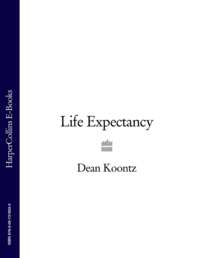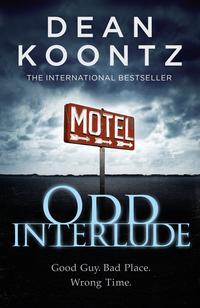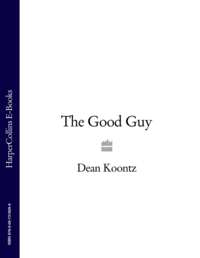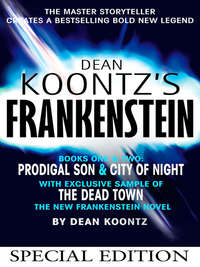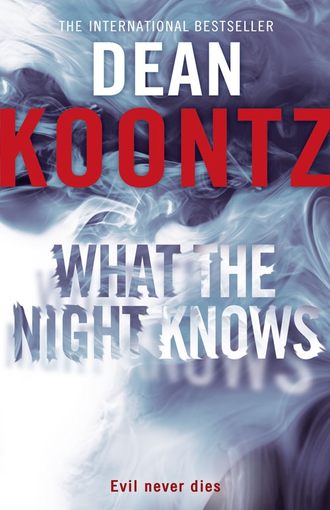
Полная версия
What the Night Knows
As he retreated from the study into the hallway, he thought he heard a jingling of tiny bells, a cold silvery sound lasting but an instant. He became as still as any living thing could be still.
The flashlight beam did not quiver on the mahogany floor.
In the sidelights that flanked the front door, the panes of glass were nearly as dark as the wooden muntins that separated them from one another. The sun had sunk far down the gullet of the storm.
John could not be sure that the sound had been real. He might have summoned it from memory, from twenty years in the past.
He went to the living room, from where the ringing might have come. The double doors – added to the archway after Sandra’s accident, to convert this space to a ground-floor bedroom – stood wide open. Bedclothes had been neatly turned down, but Sandra had died before retiring for the night. No one, with or without bells, waited there.
John had no interest in any remaining ground-floor rooms. No one had been murdered in them. The stairs did not creak. At the landing, he paused to gather his resolve.
The worst would be on the second floor. The mother and father had died quickly. But upstairs, the grandmother and the sister had struggled and suffered. Their cries would come to him.
On the landing wall, a print of John Singer Sargent’s Carnation, Lily, Lily, Rose was spectacular even in the cold LED beam. Two lovely little girls in white dresses were lighting Chinese lanterns under a bower of lilies, in a twilight English garden.
Perhaps the most charming painting of the entire nineteenth century, the scene had often elicited a smile from John when he came upon it in books of art. He didn’t smile this time.
As he turned from the picture, he had the impression that one of the girls was sprayed with blood. When he looked again, the blush on her face proved to be light from the Chinese lantern in her hands.
Upstairs, John went to the grandmother’s quarters at the front of the house, on the left side of the hall. The door stood open.
No dishwater daylight leaked through the heavy draperies. A combination night-light and air-freshener emitted a peach-colored glow and the fragrance of carnations.
Except for the punch that, to her grandson’s amusement, knocked out her false teeth, the assault on Ann Lucas had been bloodless. The aftermath John dreaded waited not here but in the sister’s room.
He flicked a switch, lighting a lamp. Half the grandmother’s room still lay in shadow. Tangled bedclothes trailed onto the floor.
On the dresser stood a collection of framed photographs. Six featured Billy alone or with others of his family. His open face seemed untouched by deceit. His eyes revealed no hint of dementia.
Celine, the sister, had a face made for mirrors and a smile of such innocence that she looked as if she knew nothing of death and everything of eternity. In a swimsuit at the shore, surf breaking around her ankles, she seemed to be a sprite spun from spray and sunlight. John couldn’t bear to look at her.
A taped outline on the carpet marked the position in which the grandmother’s body was found. In his confession, Billy had described punching her out as she sat in bed watching TV, dragging her to the floor, and waiting for her to revive before killing her face-to-face.
Staring at the taped outline, John expected to hear desperate sounds of death by strangulation – but he heard instead the silvery tintinnabulation of tiny bells, clear and icy. The tinkling lasted longer than before, perhaps two or even three seconds, and he knew this time the bells were real, not imagined.
In the subsequent brittle silence, he stepped into the hallway and switched on the ceiling fixture. The beveled-glass bowl speared that space with blue-edged blades of light.
Directly across from the grandmother’s quarters, the door to the sister’s room stood ajar. Darkness beyond.
Again, the bells. Two seconds, three.
He pocketed the extinguished flashlight and drew the pistol from his shoulder rig.
Chapter 7
Clearing a doorway under threat was always the worst. He pushed through fast, found the switch, pistol in one hand but then in both as light bloomed in a pair of bedside lamps. Left to right, head and gun tracking as one, registering few details of the room, focusing instead on target identification and places where someone might be concealed.
A closet offered the only possibility. Two sliding mirrored doors. Approaching himself and the black bore of his weapon, gun in one hand again, reaching toward the door, toward his own reaching reflection, sliding his second self aside. He found only hanging clothes, shoes, boxes on a high shelf.
He still believed the silvery ringing had been real.
He slid the door shut and looked past his reflection at the room behind him, which seemed to be filled by the deathbed, by the evil of it, the mattress like the altar of an abattoir religion.
Celine had been sitting on the edge of the bed, one leg bent and her foot on the mattress, painting her toenails. Listening to music through the earphones of her iPod, she could not have heard the struggle in her grandmother’s room.
Before throwing open the door and attacking, Billy had stripped out of his clothes and tossed them on the hallway floor. Naked, knife in hand, hot with the thrill of having garroted his grandmother with a tightly twisted red silk scarf, he burst into his sister’s room and overwhelmed her. Pain, shock, and terror robbed her of the ability to resist effectively.
The mirror image of the bed filled John Calvino with revulsion, and he heard himself breathing through his open mouth to avoid the coppery smell of the blood-soaked mattress batting that had not yet dried and would not for a long time. But the humid air had a coppery taste – or he imagined it did – that offended worse than the smell, and he clenched his teeth, his nostrils flaring.
Holstering his pistol, he turned to face the abomination, which was immeasurably more terrible than the reflection of it. His disgust was twined now with anger and pity, three threads on a needle sewing this moment into his memory, not only the moment, the scene, but also the raw emotion of it.
Then he could hear Celine, the Celine of his quasi-clairvoyant imagination: crying out in pain and terror, weeping with the shame of violation, pleading for her life, beseeching God to save her, receiving no mercy from the beast who was her brother, receiving no grace until at last, at last, the final thrust of the knife put an end to her misery.
Shaking uncontrollably, hands covering his ears without effect, John turned from the hateful bed, returned to the hallway, leaned his back against the wall, and slid down to sit on the floor. He was in three places simultaneously: this present hallway, this hallway on the murder night, and another house in a distant city twenty years in the past.
Because his father and mother had been artists and art teachers, he had perpetual access to a memory museum of renowned images. Now, before his mind’s eye rose a painting by Goya, the chilling and despair-filled Saturn Devouring His Children.
John had to sit in silence for a while, letting time past wash out of time present. The horrors of the past and of the present were unredeemable, but he held fast to a hope – wild and unreasoned in its character, but ardent – that the future could be shaped so that it would never need redemption.
Although he would have preferred to switch off the lights in Celine’s room and retreat from the house, he eventually got to his feet and crossed her threshold once more. He did not, however, look again at the dead girl’s bed.
Across her desk spilled glossy magazines published for teenagers and, by way of implausible contrast, a paperback of The Everlasting Man, by G. K. Chesterton.
Display shelves held an eclectic collection of things pleasing to Celine. Twenty ceramic mice, the largest no more than two inches tall. Seashells. Glass paperweights. A snow globe containing a quaint cottage.
Bells. Behind the mice, between two plush-toy bunnies in white bonnets and gingham dresses, on a green box in which they evidently had come, lay three miniature silver calla lilies all sprouting from one silver stem. The spathes were exquisitely shaped, but instead of a yellow spike, each enclosed a tiny silver clapper.
The stem, by which the bells could be rung, was dark with dried blood and with tarnish the blood encouraged. If the criminalists had noticed the bells, they would have bagged and taken them.
From a box of Kleenex on the desk, John plucked a tissue. He folded it into a pad and gripped the silver stem, not to preserve evidence – too late for that – but to avoid touching the blood.
On the lid of the green box under the calla lilies, in silver script, were the words Piper’s Gallery.
Shaken, the bells produced the crisp, cold ringing that he had heard three times since entering the house.
Unable to suppress a tremor in his hands, he placed the bells and the Kleenex in the box, tucked the box in a sport-coat pocket.
Back in the day, Alton Turner Blackwood had carried with him three silver bells, each the size of a thimble, clustered at the end of a handle. They were not shaped like flowers and were not as finely made as those on Celine’s shelf of small treasures.
Blackwood had been a psychopathic ritualist with an elaborate post-homicide ceremony that suggested both a strange belief system and obsessive-compulsive tendencies. When everyone in his target family was dead, he returned to the victims in the order the killings occurred and arranged them on their backs. With a drop of epoxy, he glued coins on the cadaver’s eyes: quarters that he’d painted black, always with the eagle facing up. In the mouth, on the tongue, he placed a brown disc that the crime lab identified as dried excrement.
Then the killer folded the corpse’s hands at the groin, around a chicken egg. To be sure the hands would not release the egg, he tied thumb to thumb and little finger to little finger with string.
Days prior to a slaughter, he prepared the eggs by drilling two tiny holes in each to drain the contents. Then he inserted a tightly rolled slip of paper through a hole into the well-dried, hollow shell. If the body was male, the paper carried the hand-printed word servus; if female, serva. They were the masculine and feminine forms of the Latin noun that meant “slave.”
After the cadavers had been accessorized to suit him, Blackwood had stood over each, ringing his triune bells.
Billy Lucas had not rearranged his four victims but had left them lying as they died. He didn’t conduct a ritual using black quarters, dried excrement, or hollow eggs. Evidently, however, he rang the tiny bells.
The delicate silver calla lilies featured no engraving.
On each of Blackwood’s bells had been the word RUIN.
John clearly remembered Billy with the almost wistful smile, standing on the farther side of the glass partition.
You mean – what was my motive?
You haven’t said why.
The why is easy.
Then why?
Ruin.
John switched off the lights in Celine’s room and left the door ajar as he had found it.
In the hallway, he stood listening to the house. No floorboards protested, no hinges creaked. No shadow moved.
He went to Billy’s room.
Chapter 8
The case detectives – Tanner and Sharp – had searched Billy’s room, leaving a bit less disorder than a burglar would have caused.
A few drawers in the highboy were half open. Tanner or Sharp had rummaged through the clothes therein, leaving them in disarray.
When they searched between the mattress and the box springs, they had not entirely disarranged the chenille spread.
On the nightstand stood a digital alarm clock. The numbers were not flashing as they had flashed on the kitchen clock.
John searched the desk, the closet, the nightstand, with no expectation of finding anything the other detectives had overlooked.
Previous to his killing spree, Billy Lucas’s interests had been, judging by the evidence, entirely wholesome. Sports magazines. Video games, but not particularly violent ones.
Bookshelves held a couple hundred paperbacks. John read each spine. Science fiction, fantasy, mainstream fiction: The boy’s interests were varied, but he possessed not a single true-crime book.
The computer on the desk was operative. Current department procedure in a case of this kind would have been to make a full backup of every document in the directory and take that, instead of the entire hard drive, for review later. With Billy’s confession and his commitment to the state hospital, no detective would have discovered – might ever discover – what the computer contained.
Before reviewing the contents in alphabetical order, John scanned the directory for intriguing key words. In less than half a minute, he found a document titled CALVINO1. Then CALVINO2.
The first contained photos downloaded from an Internet site devoted to serial killers and mass murderers. Here were Tom and Rachel Calvino, John’s mother and father. Also Marnie and Giselle, his sisters, at the ages of ten and twelve.
The photos accompanied the account of Alton Turner Blackwood’s fourth and final massacre of a family. The document did not contain a picture of the killer; apparently none was ever taken of the drifter during his life, and the postmortem shots in the medical examiner’s file were sequestered under a court order that protected young John’s privacy and that was never revoked.
For the same reason, John’s photo was not included. Besides, the site depicted only victims, and he was the sole survivor.
On the screen, his sisters were so lovely.
Many years had passed since he’d been able to look at photos of them. He had avenged them, for what that was worth. But if he had done something differently on that long-ago night, if he had not done a thoughtless thing that he had done, one of his sisters or perhaps both of them might still be alive.
Although he loved their faces, he could not bear the sight of them. He exited the document.
The atmosphere in this murder house grew more oppressive by the minute: the rain streaming down the windows, the humid air, a deathly stillness yet a persistent impression that someone listened, waited, and prepared for him in the nearby hallway or in another room.
He closed his eyes and summoned in memory a favorite painting, Pieter Bruegel’s Hunters in the Snow. This scene of a sixteenth-century Belgian town in a winter twilight, illuminated by a recent snowfall, was full of movement yet serene, somber yet enchanting. Contemplation of it always calmed John – until now.
Johnny.
At the state hospital, the boy had called him Johnny. Having read about Alton Blackwood, the kid knew John had slain the killer.
Here seemed to be proof that Billy patterned his killing spree after Blackwood’s murder of the Valdane family twenty years earlier.
When John retrieved the second document, CALVINO2, he discovered five photographs, the first of himself. It was part of a newspaper article about a citation for valor that he and his sometime partner, Lionel Timmins, had received more than two years earlier.
In the picture, he appeared uncomfortable; in fact, he had been embarrassed. Having survived, as a boy, when everyone else in his family had died, he could do nothing as long as he lived that would make him, in the balance, deserving of an award for valor.
He had tried to decline the presentation, but Parker Moss, Area 1 commander – who oversaw Homicide, Missing Persons, and Robbery, in addition to other bureaus, details, and units – insisted he attend and accept. Awards for valor were good PR for the department.
The second photo in CALVINO2 was of Nicolette. Nicky. It was from the website of Lannermil Galleries, a fine-art dealer, the primary representative for her work. She looked radiant.
John’s palms were damp. He blotted them on his pants.
The file also contained photos of their son, thirteen-year-old Zachary, and their daughters, eight-year-old Minette – whom they all called Minnie – and Naomi, eleven. These three were snapshots, taken a month earlier, on the evening of Minnie’s eighth birthday. The only people present had been him, Nicolette, and the three kids.
John could think of no way that these pictures could have been transferred to Billy Lucas’s computer. No way.
Nevertheless, he recognized the document for what it must be: a file of homicidal desire, photographs of targets, the beginning of a murder scrapbook. Evidently Billy had intended at some point to kill them all, just as Alton Blackwood had wasted all but one member of the previous Calvino family.
After exiting the document, John looked at the nearest window down which rain washed in the fading daylight, and he thought of the dark urine flooding across the glass partition between him and Billy.
His disquiet quickened into fear. The house was warm, but he was chilled. He shivered.
He did not feel less of a man or less of a cop for being afraid. Fear was useful if it didn’t foster paralytic indecision. Fear could clarify and sharpen his thinking.
Calling up the directory again and scrolling through it, John searched for other document titles that might be surnames. Perhaps Billy had selected and researched other target families.
Whatever the young killer’s plans had been, surely they were now of no concern. The security at the state hospital was layered and reliable. He could not escape. The psychiatric board would not deem him cured at least for decades, if ever; they would not turn him loose.
Yet intuition warned John that his family was a target. The taut wire of his survival instinct vibrated, it hummed.
When he found no obvious surnames used as document titles, he closed out the program and shut down the computer.
From within the desk came a few bars of a song that John didn’t recognize. When he pulled open a drawer, the bars repeated, and he picked up a cell phone that must have belonged to Billy Lucas.
No caller ID appeared on the display.
John waited through fourteen repetitions of the song bite. When the call was not sent to voice mail, the caller’s persistence gave him the reason he needed to answer.
“Hello.”
He received no reply.
“Who’s there?”
Not a dead line. The hollow silence was alive, the caller unresponsive.
The best way to engage in any game of intimidation was to play boldly by the rules of the would-be intimidator. John listened to the listener, giving him no satisfaction.
After half a minute, a single word whispered down the line. He could not be sure, but he thought it sounded like Servus.
John waited another half minute before he terminated the call and returned the phone to the drawer.
At the door, when he extinguished the bedside lamps with the wall switch, rhythmic strobes of green light drew his attention to the fact that the clock radio, which had been keeping time when he first entered the room, was now flashing 12:00, 12:00, 12:00. …
When he stepped into the upstairs hallway, where he had left the overhead lights on, a more conventional ringing came from a telephone toward the back of the house. After a hesitation, John followed the sound, pushed open a door, clicked on a light, and found the former master bedroom, where much of the living-room furniture was now stored. The phone rang and rang.
He didn’t know what might be happening. He suspected that the worst thing he could do was encourage it, and he switched off the lights, closed the door.
In the hall, at the head of the stairs, he extinguished the ceiling fixtures – and darkness folded around him like great black wings, the landing window offering no relief.
His heart beat faster as he fumbled for the flashlight in one of his sport-coat pockets. The LED beam painted coils of light on the walls, made the pattern in the stair runner seem to wriggle with life, and darkled down the polished-mahogany railing.
Descending past Carnation, Lily, Lily, Rose, he was peripherally aware of something new and monstrous about the painting, the Chinese lanterns too bright, their orange color smeared across too much of the canvas, as if one or both of the little girls in white dresses had been set afire, but he refused to look directly.
The telephones shrilled in the living room, study, and kitchen. The pause between each ring seemed to be shorter than usual, the electronic tones harsher and more urgent.
He snared his raincoat from the newel post, didn’t pause to put it on. When he threw open the front door, the phones stopped ringing.
Stepping onto the porch, which lay now in the grip of night, he thought he saw a figure on the padded glider to his left, where Billy Lucas had once sat naked and blood-soaked to wait for the police. But when John swept the glider with the flashlight, it proved to be unoccupied.
He locked the house, slipped into his raincoat, found his car keys, and hurried into the rain, forgetting to put up his hood. On his head and hands, the downpour felt as cold as ice water.
In the car, as the engine turned over, he heard himself say, “It’s begun,” which must have been an expression of a subconscious certainty, for he had not meant to speak.
No. Not certainty. Superstition. Nothing had begun. What he feared would not come to pass. It could not. It was impossible.
He reversed out of the Lucas driveway, into the street, fence pickets flaring bright and shadows leaping.
The wipers swept cascades off the windshield, and the rain seemed foul, contaminated.
In the fullness of the night, John Calvino drove home to his family.
From the journal of Alton Turner Blackwood:
I am Alton Turner Blackwood, and I remember …
The south tower was chiseled stairs and stone walls spiraling up four stories to one round room, fourteen feet in diameter. Four pairs of leaded windows, beveled glass, crank handles to open. A truss-and-beam ceiling. From one of the beams, she hanged herself.
The family’s fortune started from railroads. Maybe it was honest money then. Terrence James Turner Blackwood – Teejay to his closest associates, who were not the same thing as friends – inherited the whole estate. He was only twenty-one, as ambitious as a dung beetle. He grew it bigger by publishing magazines, producing silent films, developing land, buying politicians.
Teejay worshipped one thing. He didn’t worship money, for the same reason a desert dweller doesn’t worship sand. He worshipped beauty.
Teejay built the castle in 1924 when he was twenty-four. He called it a castle, but it wasn’t one. Just a big house with castle parts plugged on to it. Some public rooms were accidentally lovely. Outside, from every angle, it was an ugly pile.
He worshipped beauty, but he didn’t know how to create it.
In one sense, the house was the opposite of Teejay. He was so handsome you could call him pretty. His worship of beauty was in part self-worship. But inside, he was as ugly as the outside of his house. His soul was not bejeweled, but encrusted. Not even Teejay could have named some of the needs that formed that crust.
The immense house was called Crown Hill, after the knoll on which it stood. The 280-acre property lay along the northern coast, which has always been a dangerous length of shore. Every coast is dangerous, of course: Land falls away to the chaos of vast waters.
Jillian Hathaway was the most famous and beloved actress of silent films. She made two talkies, as well. One became a classic: Circle of Evil. She supposedly married Terrence Blackwood in Acapulco in 1926. They were never wed. She moved in to the castle that wasn’t. In 1929, at the age of twenty-eight, she retired from films.


